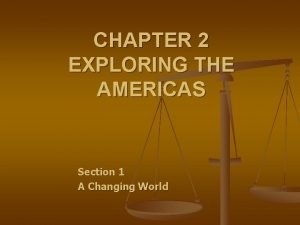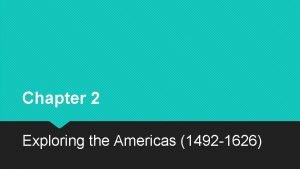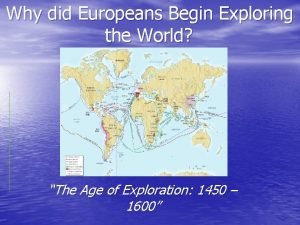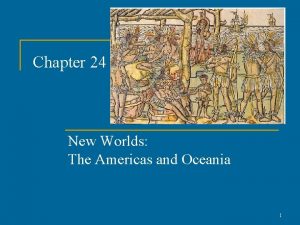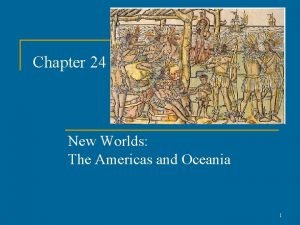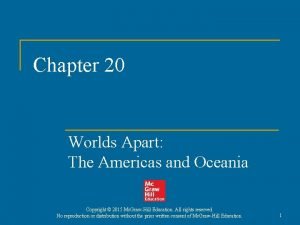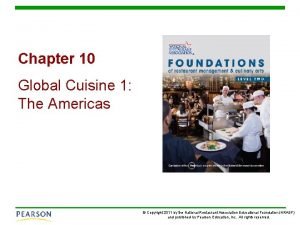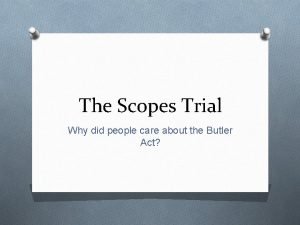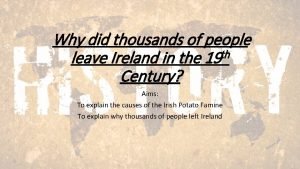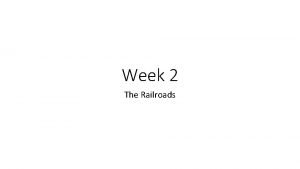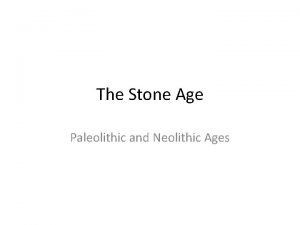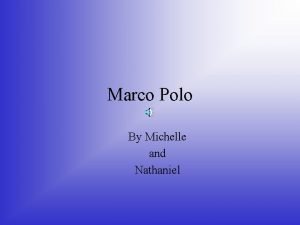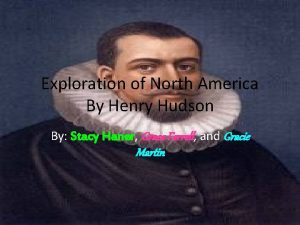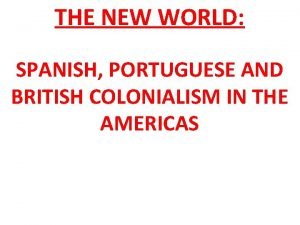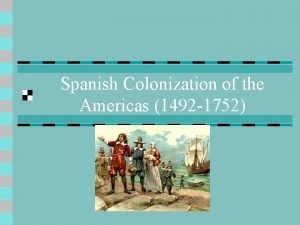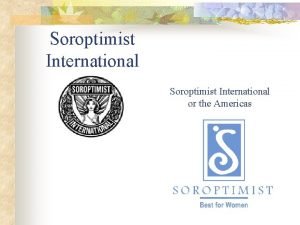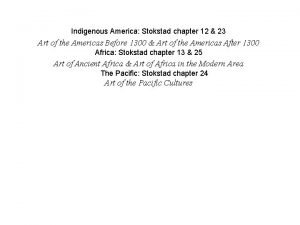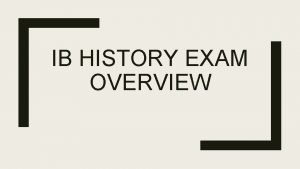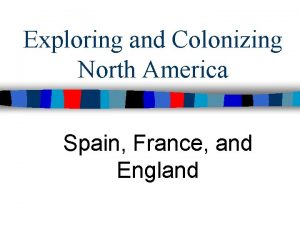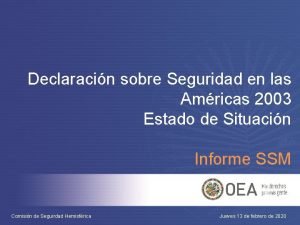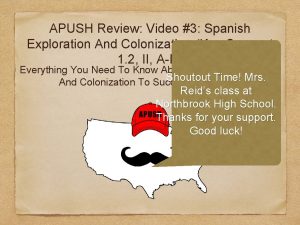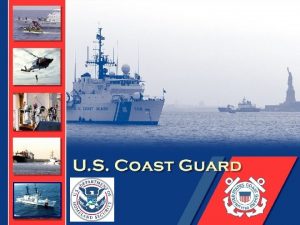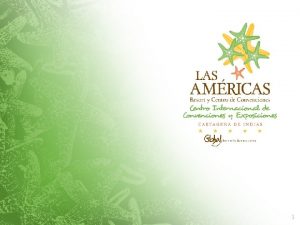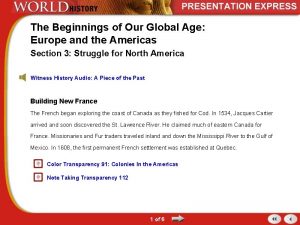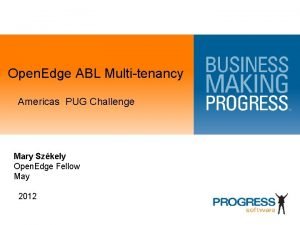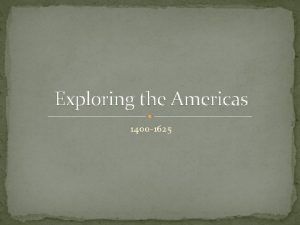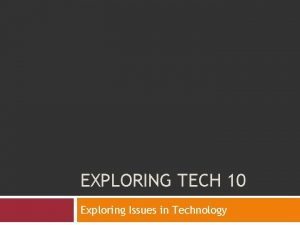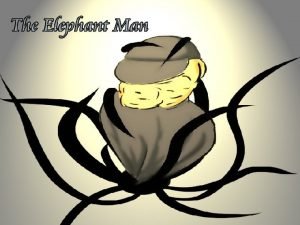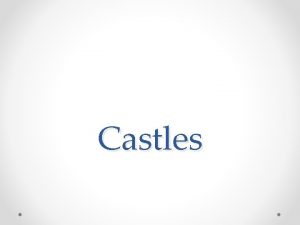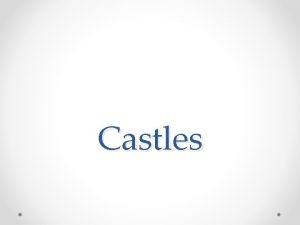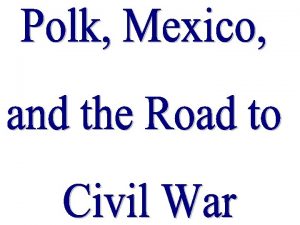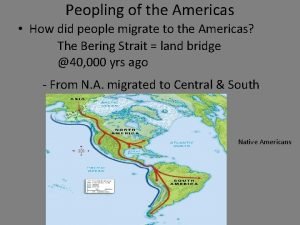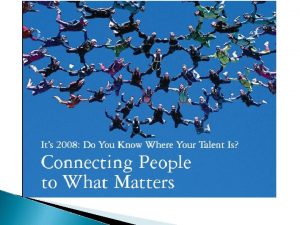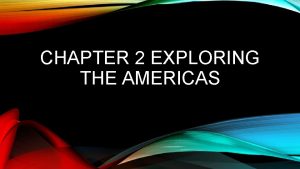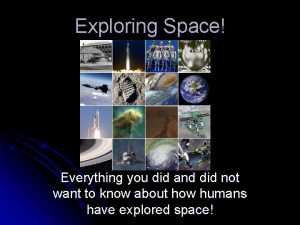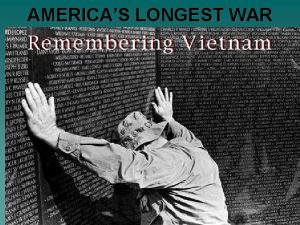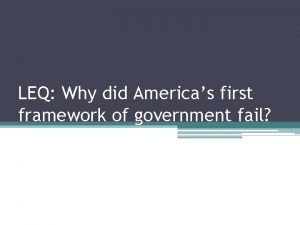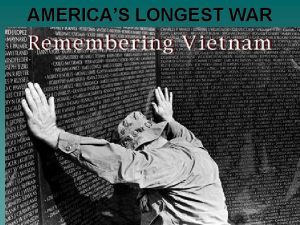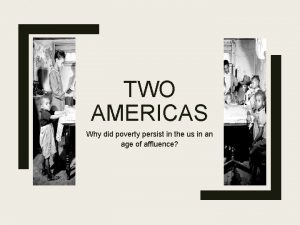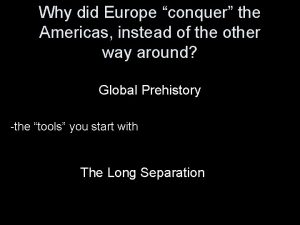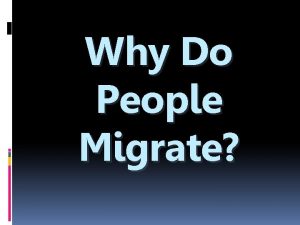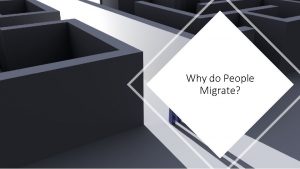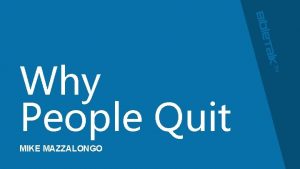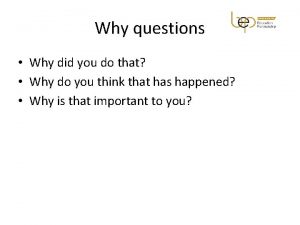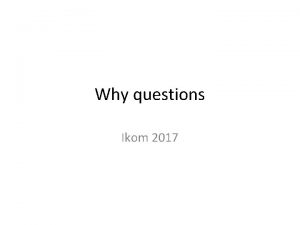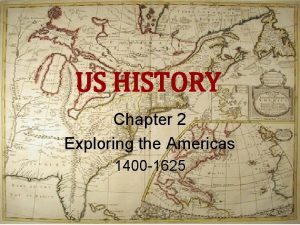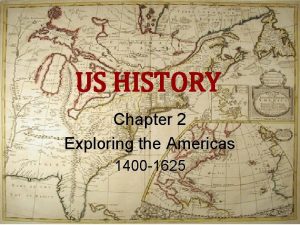Chapter 2 Exploring the Americas Why Did People
































- Slides: 32

Chapter 2 Exploring the Americas

Why Did People Explore? 1. Gold/Riches 2. Curiosity 3. New Land gained 4. Fame 5. Trade Routes 6. Religious Freedom

Chapter 2 – A Changing World Section 1 Explorers Reach the Americas • 1 st to reach Americas were the Norsemen (Norway)- 975 A. D. • They landed in Newfoundland from Greenland Iceland. • Settlement did not last long and no written record of Leif Erickson and his people.

Europe gets ready to explore the world On the European Continent the Middle Ages are just ending. The period of isolationism is over and the people have moved into the Renaissance.

Europe becomes ready to explore cont. The Feudal System ends. Middle Class grows (merchants, traders etc. ) Crusades have ended and people are returning from the East with many new ideas.

Europe becomes ready to explore cont. Marco Polo visits Asia and returns to tell about it. Writes a book and details all of the riches in the East for trading. Renaissance begins in the mid 1300’s and lasts until about 1600. Lots of creativity and experimentation. (Michelangelo, Leonardo da Vinci, Galileo etc. )

Technology Improves • Portugal leads this, but it spreads to all countries • Better Maps • Better instruments- astrolabe and magnetic compass • Better ships – new sails, better hull design for shallow water

Africa is the first area to be greatly explored • Close proximity • Could always see land • Knew it was already there Ghana, Mali, Songhai – three empires in Africa that expose Europeans to new goods and ideas

Chapter 2 – Early Exploration Section 2 Portugal and the Age of Exploration Prince Henry of Portugal (wanted to make Portugal a world power) 1. Find an ocean route around Africa to Asia. 2. Locate the source of the gold that came from South Africa. 3. Set up navigation school (built better boats, mapped coastlines etc. )

Age of Exploration (1400’s/1500’s) started by the Portuguese • Learned much about Africa (shape and size) and its people (Ghana, Mali, Songhai) • Developed new trading partners within Africa • Sailed 1, 000 miles out into the Atlantic (Azores Islands) • Slave trade begins in Portugal

• 1488 – Bartholomew Dias reaches the southern tip of Africa and ends up going into the Indian Ocean. • Cape of Good Hope (because India would be close) 1497 -1498 Vasco da Gama lands on the coast of India after traveling around Africa and on through the Indian Ocean.

Portugal continued to explore and expand its trading empire. Actually reaching Brazil (Pedro Cabral) and setting up a regular trade route from Europe to India

Columbus Reaches the Americas • Lifelong quest to reach Asia by sailing West from Europe. Thought world was round and much smaller than it is. • Italian • Studied in Portugal, but they would not finance the voyage he wanted to take. • For several years he attempts to get backing for his voyage - Queen Isabella and King Ferdinand of Spain. (Christianize and riches)

Columbus 1 st voyage • August 3 1492 – October 12 1492 (70 days) • Lands in the Bahamas (called the island San Salvador) • Meets the first Native Americans. Named Indians because he believed he was in India. • Also found Cuba (flamingos and tobacco) • Found Hispaniola (Haiti, Dominican Republic) and built a fort. First residence of Europeans in the New World. • Returns home a hero and more voyages are okayed.

Columbus makes three more journeys • Jamaica-2 nd voyage • Venezuela-3 voyage • Central America-4 voyage On 2 nd voyage he founds Santo Domingo- the first permanent European colony Very little gold is found and Columbus does not rule the colony well. He falls out of favor with Spanish King and Queen. Returns to Spain in 1504 and dies in 1506.

Other explorers of America • Amerigo Vespucci- 1502 an explorer who was the first to realize that Columbus had found new lands (“New World”). America is named after him • Balboa – 1513 first explorer to see the Pacific Ocean when he treks across Panama • Magellan- 1520 -1522 Named the Pacific. First to sail around the world. Around S. America across Pacific to Philippines (Magellan is killed) ship continues and makes it back to Spain

Chapter 2 – Spain In America Spanish vs. Aztecs – Montezuma vs. Cortes • Aztecs believe that Cortes is a god. • Using this the Spanish are able to infiltrate Tenochitlan and capture Montezuma. • Melt down all of the gold that they can. • When the Aztec people revolt Montezuma is killed by a thrown rock. • Spanish are driven from the city, but diseases have already begun to weaken the people (small pox) • 10 months later, Cortes returns to Tenochitlan and the Aztecs are defeated. • The Spanish destroy the city and Mexico City is built on top of it. Section 3

Tenochitlan


Spanish vs. Inca (Atahualpa vs. Pizarro) • Spanish hear of riches in South America. • Pizarro with 180 soldiers crosses Panama • Pizarro kills many Inca and captures Atahualpa. • Inca’s pay a ransom of $65 million, but Pizarro kills him anyway. • Pizarro then sends troops out to conquer all Incan land, except Brazil (Portugal). • Some areas fall easily, others hold out for 40 yrs. • Peru becomes Spain’s richest colony.

Macchu Picchu (Incan ruins)

Remains of Incan empire

Mexico and Peru were rich in silver and gold and many other conquistadors went in search of it. Florida • Ponce de Leon- 1513 searching for gold and fountain of youth. • A fort was set up in 1565 and grew into a city St. Augustine (oldest city in U. S. started by Europeans).

Other explorers of the Spanish empire • Alvar Nunez Cabeza de Vaca- trekking across Texas on their way back to New Spain after a ship wreck New Mexico, Arizona, Colorado, Kansas, and Texas • Francisco Vasquez de Coronado- explored the southwest in search of rich cities of gold. No luck, but did gain more land. Hernando de Soto –search for cities of gold. Ends up gaining land in Southeast U. S. and seeing the Mississippi River.

European Claims to Americas • Spain conquers Cuba, Puerto Rico, and Jamaica • Native Americans - killed or enslaved by Spanish • (1510) Spanish set up plantations to produce crops - Sugarcane and cotton. • Native Americans were also taken back to Spain and sold into slavery. • Diseases were spread back and forth • Catholicism

Spanish Empire in the Americas 1. Peru- South America 2. New Spain- Central America northward up through Mexico and islands in the Caribbean Spain – yellow Portugal- pink

Spanish Settlements • Pueblos (towns)Centers of trade, had a church (catholic) and gov’t buildings • Missions Religious communities, small town, some surrounding farmland a church (catholic) • Presidio (fort) usually near a mission, soldiers lived here and were responsible to protect an area.

Social Classes in New Spain 1. Penisulares • People born in Spain. They held the highest positions. Owned most land had the best jobs. 2. Creoles • Spanish parents, but born in New Spain. Still could have important positions. 3. Mestizos • Mixed Spanish/Native American descent. Workers, but not slaves. Most of present day Mexico is made up of descendants of these people. 4. Native Americans / Africans (largest group) • Slaves Women had little opportunity in Spanish culture.

Borderland Missions from 1560 to 1820 • Hundreds were set up in New Mexico, Arizona, California, Florida, Georgia and Texas. • California - Russian traders began to move in (biggest thing was that they wanted no one else to move in).

Chapter 2 – Exploring North America Section 4 • Other European nations begin to set their sights on land in the New World. • (Protestant Reformation) and the drive for riches lead England, France and the Dutch to send explorers. • Columbian Exchange.

Northwest Passage • England - John Cabot (Newfoundland) • France - Verranzano ; Cartier- explore east coast of North America and find St. Lawrence River • Dutch - Henry Hudson

France in the New World • fur trapping and trading network across northern North America • Set up city of Quebec (Samuel de Champlain) Dutch settlements • Dutch West Indies trading company based in present day New York. • purchase Manhattan Island from Natives for about $24 dollars. This becomes New York City
 Chapter 2 exploring the americas study guide
Chapter 2 exploring the americas study guide Chapter 2 exploring the americas
Chapter 2 exploring the americas Chapter 16 people and empires in the americas
Chapter 16 people and empires in the americas Why did europeans begin exploring
Why did europeans begin exploring Why why why why
Why why why why Chapter 24 new worlds the americas and oceania
Chapter 24 new worlds the americas and oceania Chapter 24 new worlds the americas and oceania
Chapter 24 new worlds the americas and oceania Chapter 24 the americas and oceania
Chapter 24 the americas and oceania Worlds apart the americas and oceania
Worlds apart the americas and oceania Chapter 10 global cuisine 1 the americas
Chapter 10 global cuisine 1 the americas Why did orwell use animals instead of people
Why did orwell use animals instead of people Why did people care about the butler act
Why did people care about the butler act Join the roman army
Join the roman army Goto/thleave
Goto/thleave Why did robber barons bribe people in congress?
Why did robber barons bribe people in congress? Aleppo and jericho
Aleppo and jericho Paleolithic age
Paleolithic age When did marco polo start exploring
When did marco polo start exploring Why was henry hudson exploring the arctic ocean?
Why was henry hudson exploring the arctic ocean? Don't ask why why why
Don't ask why why why Spanish caste system in the americas
Spanish caste system in the americas Spanish colonization of the americas
Spanish colonization of the americas Soroptimist international of the americas
Soroptimist international of the americas Art of the americas before 1300
Art of the americas before 1300 Ib questions
Ib questions Spanish north america
Spanish north america Declaración sobre seguridad en las américas 2003
Declaración sobre seguridad en las américas 2003 Spanish cast system
Spanish cast system Americas guardians mc
Americas guardians mc Centro internacional de convenciones
Centro internacional de convenciones The beginnings of our global age europe and the americas
The beginnings of our global age europe and the americas Transversal de las americas
Transversal de las americas Openedge multi-tenant database
Openedge multi-tenant database
